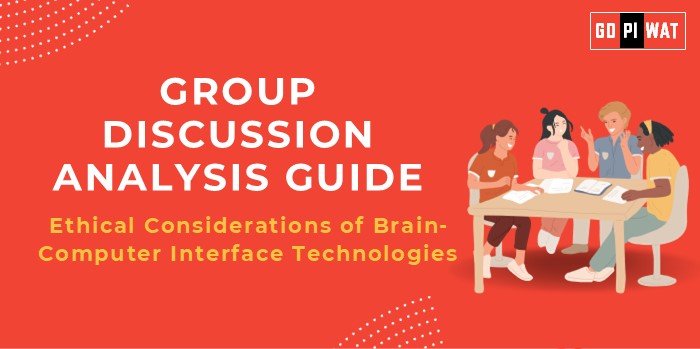📋 Group Discussion Analysis Guide: Ethical Considerations of Brain-Computer Interface Technologies
🌐 Introduction to the Topic
- 🔍 Opening Context:
“Brain-Computer Interface (BCI) technologies are at the frontier of innovation, merging human cognition with computational power. Their implications span medicine, defense, and consumer electronics, but they raise significant ethical questions.” - 📖 Background:
BCI aims to enable direct communication between the brain and external devices. Initially developed for medical applications like restoring mobility, its scope now includes memory enhancement, gaming, and even military use. Ethical concerns revolve around autonomy, privacy, and societal inequities.
📊 Quick Facts and Key Statistics
– 🌍 Global BCI Market Value: $2 billion (2023), projected to reach $5 billion by 2030.
– 🏥 Primary Use Cases: Medical applications account for 55% of current use, with growing interest in non-medical sectors.
– 🔒 Privacy Concerns: Over 75% of surveyed individuals expressed concern about data misuse in BCI applications.
– ⚖️ Regulatory Gap: Few countries have established specific frameworks for BCI regulation.
– 🏥 Primary Use Cases: Medical applications account for 55% of current use, with growing interest in non-medical sectors.
– 🔒 Privacy Concerns: Over 75% of surveyed individuals expressed concern about data misuse in BCI applications.
– ⚖️ Regulatory Gap: Few countries have established specific frameworks for BCI regulation.
🤝 Stakeholders and Their Roles
- 🏛️ Government Agencies: Regulate and fund research, e.g., FDA approvals in the US.
- 🏢 Private Companies: Develop and market BCI technologies, including Neuralink and Synchron.
- 🏥 Healthcare Systems: Integrate BCIs for patient rehabilitation.
- 🎓 Ethicists and Legal Experts: Frame policies addressing consent, privacy, and societal impact.
- 👥 Citizens and Patients: Direct beneficiaries or potential subjects of these technologies.
🏆 Achievements and Challenges
✨ Achievements:
- 🏥 Medical Breakthroughs: Restored mobility for paralyzed individuals using BCI-controlled exoskeletons.
- 🧠 Cognitive Enhancements: Early success in memory and focus augmentation.
- 📈 Economic Potential: Projected CAGR of 15% between 2024-2030.
- ⚙️ Technological Advancements: High-resolution neural decoding, reducing error rates in real-time applications.
⚠️ Challenges:
- 🤔 Ethical Ambiguity: Consent complexity for individuals with impaired cognition.
- 🔒 Data Security: Potential for brain-data hacking, with no clear cybersecurity protocols.
- ⚖️ Access Inequality: High costs limit accessibility, deepening societal inequities.
- 🌍 Global Comparisons: China and the EU have begun integrating ethical oversight into their AI governance strategies, but global consensus is lacking.
🧠 Structured Arguments for Discussion
- ✅ Supporting Stance:
“BCIs are revolutionizing healthcare and unlocking human potential, particularly for individuals with disabilities.” - ❌ Opposing Stance:
“Ethical and societal risks of BCIs outweigh their benefits, given the current lack of regulation and potential for misuse.” - ⚖️ Balanced Perspective:
“While BCIs offer transformative benefits, they necessitate strict ethical guidelines and equitable implementation frameworks.”
🎯 Effective Discussion Approaches
- 📜 Opening Techniques:
- 💡 Technological Milestone: “Neuralink’s latest trials have demonstrated memory enhancement in patients with Alzheimer’s.”
- 📖 Ethical Case Study: “A 2022 incident where unauthorized neural data was extracted highlights the urgent need for ethical regulation.”
- 🔄 Contrast Approach: “While BCIs promise empowerment, they simultaneously pose existential ethical dilemmas.”
- 🔍 Counter-Argument Handling:
- Recognize merit in opposing views but emphasize safeguards.
- Cite case studies or data on successful implementations.
- Suggest plausible solutions like regulatory frameworks or public-private collaborations.
🔍 Strategic Analysis of Strengths and Weaknesses
- 💪 Strengths: Enhances medical rehabilitation, boosts cognitive potential, high economic impact in emerging tech.
- ⚠️ Weaknesses: Ethical and privacy concerns, cost barriers for mass adoption.
- 🚀 Opportunities: Collaborative global policy development, integration with AI and IoT for advanced applications.
- ⚡ Threats: Unregulated exploitation, increased socioeconomic divides.
🎓 Connecting with B-School Applications
- 🌟 Real-World Applications: Ethical frameworks as case studies in operations and governance courses; business models for equitable tech deployment.
- ❓ Sample Interview Questions:
- “How should governments regulate BCI technologies to balance innovation and ethics?”
- “What business models can ensure accessible BCI deployment?”
- 💡 Insights for Students:
- Explore intersections of ethics and technology.
- Consider implications for leadership in tech-driven industries.


